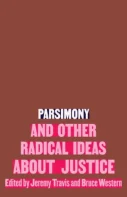Parsimony and Other Radical Ideas About Justice
Editors: Jeremy Travis & Bruce Western
Publisher: The New Press, 2023. 400 pages.
Reviewer: Jeffrey S. Adler | January 2024
Across racial, ethnic, class, gender, regional, and religious lines, most Americans believe that the criminal justice system is broken. Rates of violence, though low by historical standards, tower above those of other affluent nations; the United States suffers from the highest incarceration rate on the globe and stands virtually alone in its embrace of capital punishment; prisons brutalize and traumatize inmates; recidivism is legion; and crime tears at the fabric of families, communities, and society. Despite persistent missteps, flawed prescriptions, destructive policies, and systemic failure, the machinery of law enforcement in the United States is also horrifically expensive, consuming vast resources that might otherwise support public health, education, and social services. Conservative and liberal Americans, reactionary and progressive activists, and Republicans and Democrats disagree about the causes and solutions for this searing crisis. Still, they generally agree that the criminal justice system is defective.
In the spring of 2018, Columbia University’s Justice Lab launched the Square One Project, a multi-year initiative to reimagine justice in the United States. The organizers invited a diverse group of twenty-nine scholars, practitioners, and legal observers to participate in a series of “conversations” about rethinking and remaking the nation’s criminal justice system. The participants included researchers, activists, community organizers, wardens, judges, and policymakers. Intellectually engaged, deeply committed to systemic reform, and passionate about social justice, they discussed and debated this crisis. Editors Jeremy Travis and Bruce Western gathered nineteen essays from this group and their meetings and published them as Parsimony and Other Radical Ideas About Justice.
The unusual genesis of the anthology accounts for its notable strengths of the volume but also for a few shortcomings. The most valuable, enduring edited volumes typically combine stimulating chapters tightly focused around core themes. And, taken together, the essays in the best such collections dovetail, intersect and offer divergent perspectives on particular topics, such that the collective tapestry of ideas exceeds the sum of the individual contributions. Subsets of the essays in Parsimony and Other Radical Ideas About Justice fully achieve this lofty standard. The chapters exploring parsimony in criminal justice are especially effective and important. Presenting and analyzing evidence-based research on the impact of punitive policies and practices, essays by Daryl Arkinson and Jeremy Travis, Tracey Meares and Arthur Rizer, Vincent Schiraldi, Bruce Western, James Austin and Anamika Dwivedi focus on the impact of draconian punishment on those caught up in different layers of the criminal justice system, from pretrial incarceration to the effects of punitive sanctions on youth and violent offenders. Analyzing data from a range of settings and programs, the scholars demonstrate the harmful, counter-productive influence of deterrence-based practices and policies.
As a consequence of the intersection of class and race, for example, suspects and offenders of color and from impoverished backgrounds endure the harshest punishments, suffer from the most extreme trauma, and experience the most pronounced, persistent damage to their physical and emotional health, for zero-tolerance sentencing guidelines are typically applied unevenly and magnify racial and class inequality with predictable and disastrous results. The relatives of these victims of draconian law-and-order policies become collateral damage as well, often evicted from their homes and facing exaggerated financial challenges. For convicted offenders, the harm persists long after they have completed their sentences, and they frequently find themselves disfranchised, ineligible for many social services and educational programs, and barred from a wide range of jobs. If the goal of punitive punishment is to isolate, stigmatize, brutalize, and traumatize offenders (or suspected offenders), then the policies are wildly effective. But if the goal of American criminal justice is to reduce crime, rehabilitate those who have violated the law, and enhance social stability, then over-policing and over-punishing fail miserably and contribute to levels of violence and disorder. Harsh treatment damages individuals and harms society, making the streets less safe.
The empirical evidence these researchers unearth unmistakably documents the disastrous effects of draconian punishment. Meares and Rizer, for example, detail the myriad ways in which pretrial detention undermines any presumption of innocence. Impoverished misdemeanor suspects are often incarcerated for extended periods, even though they have been typically charged with minor offenses and convicted of no crimes. While these suspects languish in jails, sometimes for months and even years, they endure violence, receive substandard health care, and routinely lose their jobs, lofty rhetoric about any presumption of innocence notwithstanding. Nor do severe sanctions and long prison terms reduce reoffending and re-incarceration. The litany of damaging effects of incarceration will surprise few readers. Still, these scholars provide indisputable evidence charting and quantifying the harm inflicted on suspects, offenders, their families, and American society. Simply put, less punishment—the more parsimonious, restrained use of state authority—serves society. Yet, in much of the nation, lawmakers and elected officials are redoubling their commitment to aggressive policing, mandatory, zero-tolerance sentencing mandates, punitive punishment, and a “trail ‘em, nail ‘em and jail ‘em” model of criminal justice (p. 223).
The remaining fourteen essays in Parsimony and Other Radical Ideas About Justice are thoughtful and provocative but less tightly focused. Some describe innovative and effective local programs, while others offer aspirational and utopian roadmaps for the reinvention of American criminal justice, hinging on restorative justice, rehabilitation, and social progress. Still, other chapters recount the personal journeys of the authors as they confronted the horrors of carceral institutions or the biases, including white supremacy, that afflict and infect the courts. Former judges, such as Elizabeth Trosch and Nancy Gertner, and prison administrators, physicians, sociologists, clinical psychologists, and community activists share their experiences and draw from their professional training to document the dysfunction of the carceral system and to propose more humane and equitable paths toward social justice and legal reform. Some essays identify pragmatic prescriptions and discuss promising programs that promote healing and reduce crime with affordable housing initiatives, educational and job training programs, and enhanced access to health care. Other essays take the form of jeremiads, issue clarion calls for reimagining the criminal justice system, and implore “people with moral authority” to step forward and lead the way (p. 266). In combination, these chapters are insightful and stimulating but loosely connected to threads that could interweave them.
Despite the range of essays and the scope of their approaches, two perspectives seem primarily absent from the collection. First, no chapter explores or analyzes the widespread support for law-and-order policing and get-tough-on-crime mandates. Instead, nearly every essay views the crisis in American criminal justice in Manichean terms, contrasting progressive, humane, restorative approaches with ideas and policies dedicated to white supremacy and vindictive notions of justice. Flawed policies are demonized and often characterized as disingenuous, willful expressions of explicit racism. However, many scholars have delved more deeply into conservative politics and ideologies and offered explanations that extend beyond intentional, visceral evil and demagoguery. In much of the nation, such as Florida, where I live, legislators and vast swaths of voters embrace mandates and implement policies that seem undeniably counter-productive. To understand these lawmakers and proponents of destructive prescriptions, political scientists, sociologists, and historians have attempted to contextualize and explain these views instead of dismissing them as the bloodthirsty ravings of a deranged populist fringe. Parsimony and Other Radical Ideas About Justice might have benefited from including at least one essay analyzing conservative beliefs and ideologies about crime and punishment in more dispassionate terms. This perspective is not tantamount to endorsing, justifying, or defending misguided practices or harmful panaceas.
Second, the essays often view social justice in oddly ahistorical ways. Some of the otherwise impressive essays describe the current crisis in American criminal justice as a departure from long-standing American legal traditions and practices. One chapter frames the problems of the twenty-first century relative to our “incredible and storied past” (p. 99). In contrast, others contrast today’s punitive, carceral state with an era when the legal system emphasized a rehabilitative ideal. But the American past included slavery, so-called “ugly laws” that barred people with disabilities from appearing in public, and Jim Crow criminal justice, and the rehabilitative model never fully extended to people of color, religious minorities, political dissenters, the working class, or women.[1] Alternatively, other thoughtful essays explore recent policies amplifying racial disparities in criminal justice by invoking systemic racism and treating the American past as a fixed, unchanging set of customs and practices. To be sure, racial injustice and bigotry arrived with the first European explorers to North America in the sixteenth century, but racial disparities in law and criminal justice have waxed and waned over time, becoming especially pronounced in some eras and more muted in others. Attributing modern racial injustice merely to custom ignores the conditions and currents that spearheaded the harmful practices of modern policing and carceral regimes.
Even the superb essays on parsimony might have benefitted from greater consideration of the past. The contributors offer a compelling analysis of the need to rein in capacious state authority in punishment, proposing this as a panacea. But the nation’s legal history demonstrates that parsimony, by itself, does not eliminate or even reduce endemic injustice. A century ago, the criminal justice system was anemic and largely inert. Prosecutors pursued few cases, and prisons were, by modern standards, tiny. District attorneys casually and routinely dismissed homicide charges, and barely one-fifth of murder cases produced convictions. In many cities, only a tenth of homicides resulted in convictions, the rate in robbery cases hovered around 3 percent, and the conviction rate in burglary cases fell below 1 percent.[2] Huge racial and ethnic disparities existed nonetheless, and African Americans and Sicilian immigrants endured blistering discrimination at the hands of policemen, prosecutors, jurors, and judges, frequently far exceeding modern disparities. Thus, in isolation, constraints on state power have not ensured justice.
These two issues, however, should not detract from the larger, wider value of Parsimony and Other Radical Ideas About Justice. The book blends cutting-edge scholarship with trenchant analyses of the path to a more humane, equitable, and just criminal justice system.
Notes:
[1] Susan M. Schweik, The Ugly Laws: Disability in Public (New York: New York University Press, 2009).
[2] Missouri Association for Criminal Justice, Missouri Crime Survey (New York: MacMillan, 1926), 545.
Jeffrey S. Adler is a Professor of History at The University of Florida.



